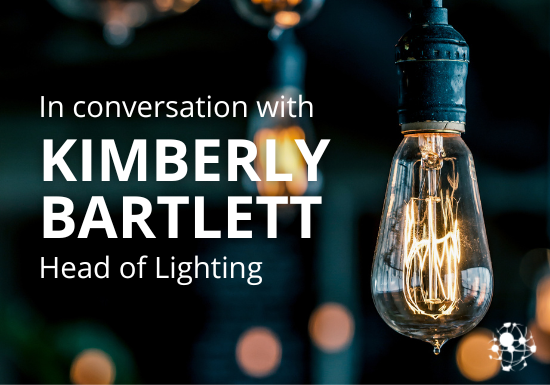
Elementa Consulting are excited to welcome Kimberly Bartlett as the new head of lighting, with a specific focus on external, infrastructure, and masterplan designs.
Did you know that lights can catch criminals, save lives, or even be a key component in driverless cars? Kimberly revealed all of this and more in our recent interview with her:
Hi Kimberly, welcome to Elementa! Can you use three words to describe your career in lighting to date?
Surprising, rewarding, exciting.
What made you choose those words?
Surprising – as most don’t usually understand the benefits of lighting design. Rewarding – as it benefits so many parts of society including health and safety. Exciting – as there is always a new interesting lighting technology helping society.
Tell us more about the safety element. Lights can’t, for instance, catch criminals…
Interestingly yes, they can. Streetlights can be used to detect criminals! For example in Chicago, where there is a lot of gun activity, sensors were attached to lights to triangulate a gunshot. The sensors were able to pinpoint the location and send a signal to the emergency services quicker than anyone would be able to phone. This allowed the emergency services a quicker response to rescue the victim whilst the police were able to catch the perpetrator quicker too. So to answer your original question, lights were able to catch criminals and save lives!
Carbon is unquestionably high on everyone’s agenda currently. How can lighting contribute to reducing carbon?
First of all – do we really need to use lighting? That would always be my first question to understand if an intelligent design could eliminate the need for artificial lighting at all and therefore use no energy. But unsurprisingly, it is impossible to eliminate lighting entirely. Historically lights used lamps within designs that use a lot of carbon but switching to LEDs uses much less energy and therefore carbon.
Just how much carbon can be saved?
If you look at a motorway, each light used is around 1.8m long and uses around 400 watts of energy – which over a long stretch of road is a fair amount which subsequently generates a lot of carbon. By switching to a LED solution that is sympathetically designed and efficiently implemented, up to 90% energy savings can be recovered.
What would be your one piece of advice for clients?
Lighting needs to be bought in at the beginning of a master plan – not at the end like it so often is. It allows lighting to be designed around the needs of the people and community. For example, a community with a retirement village incorporated will need a more enhanced lighting solution to serve the residents.
What future trends should we be looking out for in the lighting industry?
My favourite upcoming technology is LiFi, which is essentially lighting wifi. In layman’s terms, a signal is created through a flashing LED in a luminaire. Currently, it is being trialled in the Paris Metro where it is successfully allowing the visually impaired to move around safer. They are currently looking to introduce the technology into road lighting which will allow automated or driverless vehicles to talk to each other in black spots of data, so they can make sure there are no accidents and the cars are going in the right direction.
Lights are more intuitive than they seem. Any other services we should be thanking lights for?
Lighting can provide a better service that people won’t even necessarily think lights are providing them. For example, you can use light posts within a council to determine where a road is frozen, which allows the council to send a gritter to those particular roads. That reduces emissions, maintenance costs, and time for the gritting (which is usually 4 times per night) for the council.
What would be the one takeaway you hope someone takes from this interview?
Don’t let lighting be an afterthought. We take it for granted that lights are just there which means they are often introduced at the end of a design. But hopefully, with the examples given, you can see that intelligent lighting design can provide so much more than just allowing people to see, it can help communities be safer, healthier, and reduce carbon.
